PART 2: SAN DIEGO, 1971-1975
In 1971, I started studying at the University of California, San Diego. This was an incredibly rich time in my life. Not only did I study and use the facilities at UCSD, and work with the many wonderful people there, but I also made contact with other artists and musicians in the San Diego area, as well as folks in the rest of California. UCSD was a very collegial place. An example of the interactive attitude that pervaded the place in the early 70s is shown by this 1972 picture of John Silber, Kenneth Gaburo and Pauline Oliveros (back to camera) lunching together at the Matthews Campus snack bar, just across from the Music Department offices.
John Silber, Kenneth Gaburo, Pauline Oliveros - UCSD, 1972
USCD had several electronic music studios. The two that were available to me, when I arrived in 1971, were the large Buchla 100 studio, and a smaller studio with a small Moog series III which was integrated into a tape music studio. I worked in both of these, but coming from working with the large CEMS system, I was most immediately attracted to the Buchla studio. The UCSD Buchla was about half the size of the CEMS Moog, but it had a lot of unique features. It had four sequencers and 3 Buchla touch sensitive keyboard pad modules. This allowed lots of possibilities. Here's a picture of the UCSD Buchla. It had four cabinets, with a sequencer unit in the bottom of each cabinet. Two of the sequencers were 16 stage units, the other two had 8 stages.
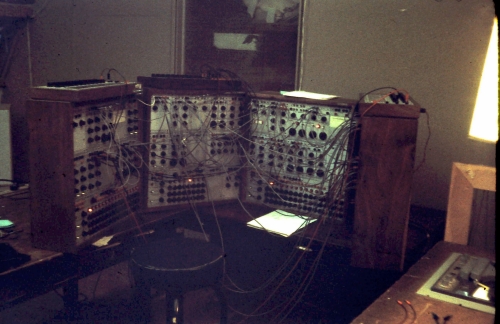
UCSD Buchla 100 System, ca. 1972
The four cabinets are turned inwards in this photo. Canadian composer Reinhard von Berg was working on the machine when this photo was taken. He turned the cabinets inward to allow himself quicker access to all the controls. When I worked on the Buchla, I had the cabinets next to each other - I preferred working on a wide flat plane.
I made a number of pieces with the Buchla 100 system. What most attracted me were the four sequencers. These enabled me to make pieces that consisted of overlapping patterns, such that I could have a piece where every note had a different timbre, because each note was produced by two or more oscillators frequency modulating each other, and all of these oscillators could change frequency independently. One of the pieces I made like this was called "Moist Days in Mid-Winter." I remember Robert Erickson, one of my teachers, liked the piece because to him, it seemed to blur the line between counterpoint and tone-colour melody. He later mentioned this piece in his 1975 book on timbre, "Sound Structure in Music."
Moist Days in Mid-Winter (1971) for multi-sequencer Buchla 100 system (excerpt)
One of the features of the Buchla system was its use of separate patch cords for audio and control signals. One of the things Joel Chadabe had been experimenting with on the CEMS Moog was the use of control signals as part of audio signals to get waveforms with changing timbre. I wanted to do this with the Buchla, but the two patch cord system frustrated this. Eventually, I made some converter cords, and was able to set up the kind of patch Joel had, and hear the changing timbres he was talking about. However, I then took things one step further, and wondered - "OK, what happens if two of these waveforms frequency modulate each other?" The answer was amazing - really wonderfully raw sounding, noisy waveforms. I made a series of pieces with these, called "Aardvarks IV" in 1972. I was never quite satisfied with them - but the nature of the sound (as well as my experience seeing Sal Martirano's Sal-Mar the previous year) convinced me that I really needed to have my own equipment. This led in two directions - first, I started to design and build my own control system, also called Aardvarks IV, and second, I got involved with Serge Tcherepnin and the People's Synthesizer Project. Here's an excerpt from the first series (1972) of Aardvarks IV pieces. This one has the title "All Hell Broke Loose as the Checkered Demon and the Boys Tussled at Dinty Moore's Bar One Bright Sunny Sunday Afternoon." Those familiar with underground comix will read in the title, and hear in the music, the influence of cartoonist S. Clay Wilson.
Aardvarks IV: All Hell Broke Loose...(1972) (excerpt)
At UCSD, my principal teacher was Kenneth Gaburo, who was involved in many of the things I was interested in - electronics, extended voice, experimental writing, multimedia, connections between music and the sciences, etc. In fact, it was seeing a performance of Gaburo's group NMCEIII when they were on tour at SUNY Albany in 1971 that made me decide that he was the person I should study with. One of the courses that Kenneth taught was a seminar in Compositional Linguistics, in which we studied many aspects of music, language, and the connections between them. Participating in this seminar was one of those life-changing experiences.
Here's an anecdote from the seminar - I've told this to a lot of people. One week, Kenneth handed us a list of techniques of English language poetry - rhyme, metaphor, litotes, acrostics, etc, and more exotic things like carmen figuratum etc. He told us that the assignment for the following week was twofold - 1) we were to write a short poem using as many of the techniques listed in the handout as possible, and be ready to show how we used them, and be ready to read them in class, and 2) we were to bring in a love poem (or other poem) we had written in high school, or late adolescence. The next week we all showed up with our structuralist poems, and our high-school gushings. First we read the structural poems and talked about their structures. Then Kenneth collected our love poems, quickly read them, and like the show-off he delighted in being, proceeded to analyze these poems in real time, showing us how they all had far more structure in them than any of our consciously written structuralist gems. He then said something like: "So now you see that structure is deeply embedded in everything you do, whether you consciously put it there or not. So you don't have to be afraid of structure, or it's lack. You're free to work with it in any way you want - it will always be there, whether or not you consciously control it." For me, at the time, this was liberation. I had been interested in improvisation, and in complex structure, and in very simple sounding objects. This lesson of his enabled me to do all of these activities, plus many others, without a sense of conflict between them.
Another time, Kenneth conducted a workshop for us on "breathing as a contrapuntal system." It was what I later realized was a standard post-modern dance workshop on the breath, but the way he did it, relating every muscular motion of the body during breath to some aspect of musical-contrapuntal structure, was again, pretty heady stuff, and a real liberation.
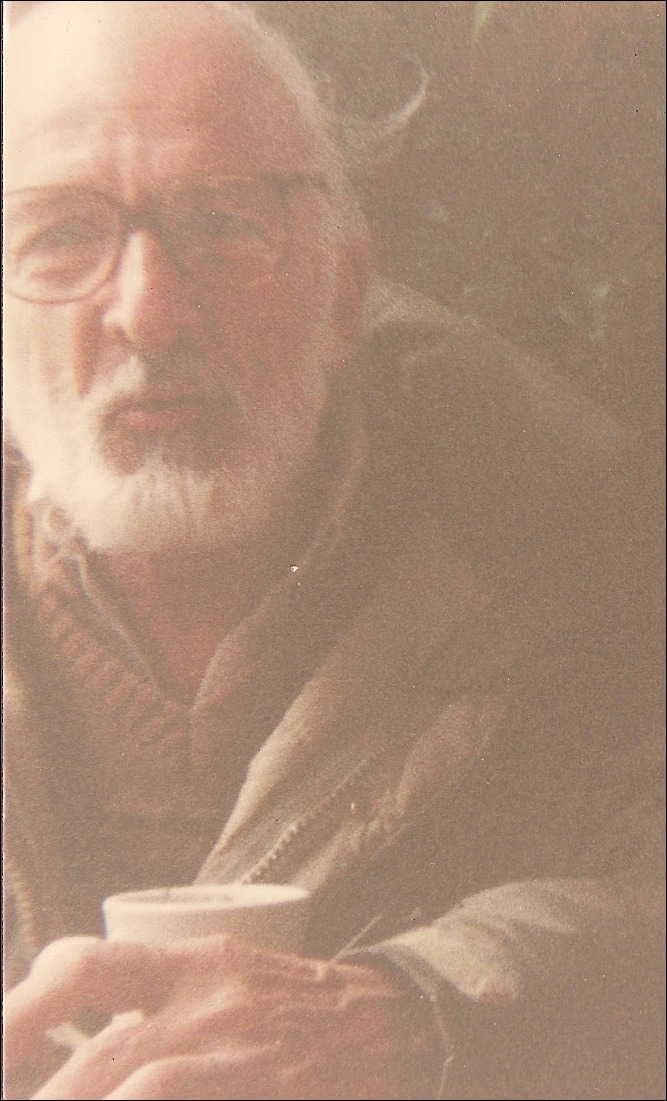

Kenneth Gaburo, 1987, Iowa City, photo by Philip Blackburn
As part of the seminar, we had to write a piece. In terms of language, I had been reading John Lilly's books on dolphin research, and was very interested not just in human language, but also in non-human communication systems. I bought a tape of a lecture of Lilly's from the Esalen Institute, and was very inspired by it. Through a mutual acquaintance, I got his permission to use excerpts from the tape in a composition involving his voice, whale and dolphin sounds. The whale and dolphin sounds I harvested off records available at the time. (This was, again, before everyone was very worried about copyright.) I was a regular visitor to the San Diego Zoo, and one of my favorite people at the Zoo was a large walrus named Fred. He performed loudly and soulfully - with the most complex sounds. I went to the Zoo with a portable tape recorder (still pretty new technology in 1972) and made several recordings of Fred in full flight. Naturally, since it was a zoo, there were lots of hairless ape sounds, but I had recorded enough to get much useable walrus material. I was convinced then, and still am, that the linguistic system of the Pacific Walrus is of such complexity that it deserves far more study than it has so far been given. Following on from a lecture of Stockhausen's that I had heard in Darmstadt in 1970, I decided to ring-modulate all these sound sources against each other to make a vocabulary of intermodulations, and used these with the standard array of tape manipulation and mixing techniques that were available in the UCSD Moog studio. Here are some pictures of the UCSD Moog Studio, showing the Moog itself, the tape recorders and auxiliary equipment, and the listening couch, which was an essential part of the environment - a place to retreat from the controls and hear your work with some space around it.
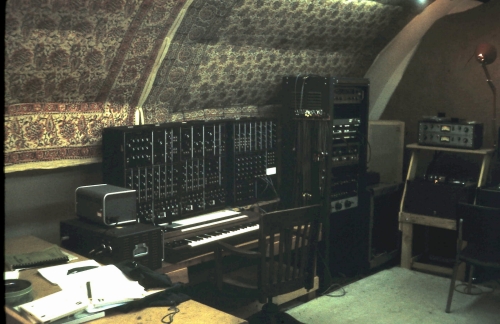
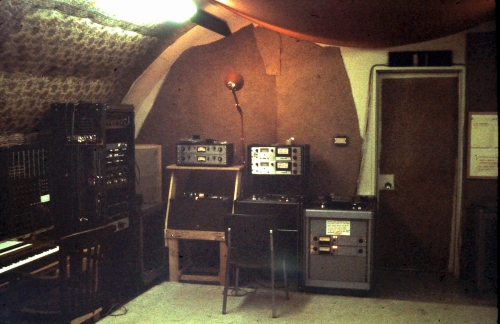
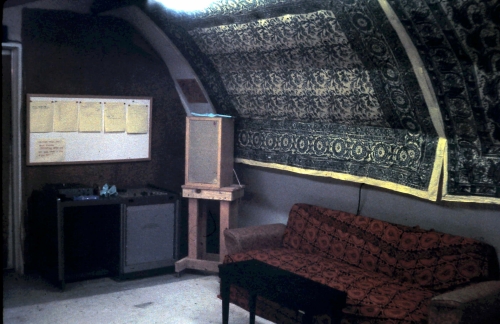
UCSD Moog and Tape Music Studio, 1972
During this project, I discovered, or developed, a skill that has proven useful ever since - the ability to clean up less than perfect (read: lousy) audio recordings. And with each new generation of audio cleaning equipment (or more recently, software), I've kept my skills up to date. This has meant occasional employment for me, as well as (following another useful tip from Kenneth) a source of interesting sound alteration, as the various sound cleaning techniques were pushed beyond their conventionally "useful" limits. This piece also was the start of my continuing interest in exploring the links between the sciences and music. The full title of this piece, however, "Real Science Comix Funnies #1: John Lilly Meets The Dolphins" acknowledges that my interest in science here, and my treatment of it in this piece, was no deeper than the treatment scientific ideas would get in a documentary science comic book.
Real Science Comix Funnies #1: John Lilly Meets the Dolphins (1972) (excerpt)
Up until this time, although I had some vague ideas that someday I might want my own studio, I was content to simply work in whatever electronic music studios were available. But one thing Kenneth Gaburo impressed on me was the necessity of having my own equipment. This could include building one's own electronics. Synthesizers at this point were well beyond the budget of a mere graduate student, but an event happened that soon showed me how convenient having my own equipment would be. Sometime in late '71 or early '72, on a visit back to New York City, I met Jim Burton and Bob Stearns, who were running a series of events in their Greene Street Loft - in the Kitchen of their loft, in fact. This series of events was called, naturally enough, the Kitchen. They introduced me to Woody and Steina Vasulka, who were then setting up a series of events at the Mercer Arts Center, which would also be called "The Kitchen." I arranged to do a concert at this new arts space in January '73, when I knew I would be back in New York from San Diego. In Albany, video artist friend Tom de Witt introduced me to George Kindler, who had a Synthi AKS synthesizer. This was a VCS 3 in a briefcase with a digital sequencer-keyboard attached to it. As I remember, the sequencer could remember a single line of maybe 512 notes. But that, with the keyboard, and the modulation possibilities of the VCS3, seemed quite enough to do something interesting with. I was especially attracted to the amplitude modulation sound of the VCS3 - that and it's funky reverb unit. At UCSD, I had been taking Pauline Oliveros's electronic music performance classes, and in those we covered, among many other things, the setting up of all sorts of tape delays. From somewhere, I can't recall where, I obtained the use of two antique Ferrograph reel to reel tape recorders, and set those up in a 7 second tape delay with feedback, with the AKS-VCS3 as sound source. This performance, a half-hour long, formed the second half of my concert at the Kitchen - my "New York debut," (hah!) as it were. After the concert, I returned the Synthi AKS to George, but the experience of walking around with my studio in a briefcase was quite a good one - it was a premonition, of course, of the laptop world I was to live in from 1990 onwards, but it also showed me the necessity of having my own studio. After all, as Kenneth said, how many pianists did not have their own piano?
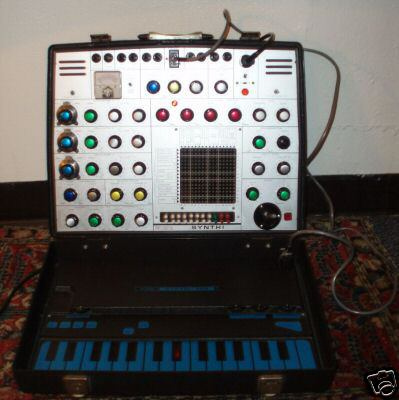
EMS Synthi AKS synthesizer, early 1970s.
One of the reasons I wanted to study with Kenneth was that I was a composer who was applying the techniques I was using in music to language, creating a verbal version of the experimental music I was creating. At Albany, as mentioned earlier, I had already recorded 18 people reading Victorian pornography (H. Spencer Ashbee's "My Secret Life") and had processed that through the CEMS Moog system - using control voltage gates to create a chopped up pornographic experimental sound poetry. (From this usage of control voltage modules to treat sound, one can see why I was frustrated with Buchla's two patch-cord system, and why I quickly made my own converter cords to get around this.) In 1973, influenced by Kathy Acker, a writer studying at UCSD who became a friend, I took 2 piles of books, extracted texts from them, and using numbers selected from the Fibonacci series, made 2 paragraphs from the book piles. I then used these two paragraphs as the basis for two further paragraphs, which were used as the basis for two further paragraphs, etc. When I got to 10 paragraphs, I stopped. I showed the text to Kenneth, who not only liked what he saw, but encouraged me to continue the process. I did so for 30 more paragraphs, copying out the remaining 30 paragraphs in one marathon close-to-24 hour session. When I showed the completed work to Kenneth, he said, "Well, obviously, you have to perform this." Taking the idea of the text as sound notation literally, we decided that every mark on the text should be performed, including punctuation, scratch outs, and the like. Since I was already involved with researching extended vocal techniques, this seemed like the natural thing to do. The resulting performance, Nighthawk, became the basis for a cycle of pieces, which eventually turned out to be 3 and 1/2 hours long. The reading of the first part, Nighthawk I, took about an hour. It was an absolutely exhausting performance. The handwriting in the two extracts from the text shown here give some idea of the energy involved in a performance.
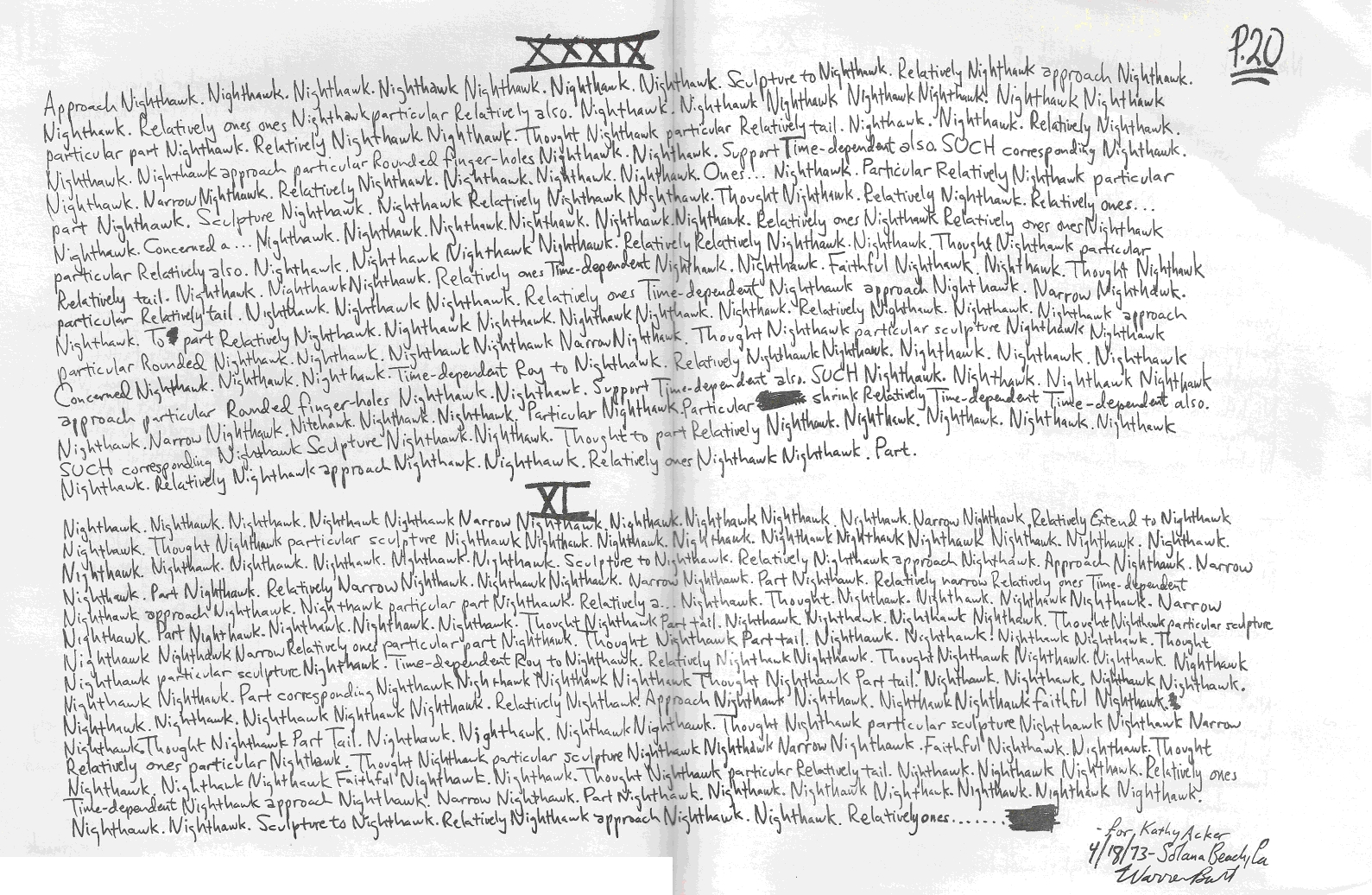
Nighthawk, Part 1 (1973) pages 1 and 20
In the spring of 1975, Ned Sublette organized a community performance of Nighthawk I, with 40 different people interpreting each paragraph differently, called "Erwartub." I have a number of photographs of that event, and I hope to be able to include them here at some future time. Eventually, in 1976, I made a version of Nighthawk I with video synthesis and slides, as well as my reading. Here is one of the slides from the 1976 multimedia version.
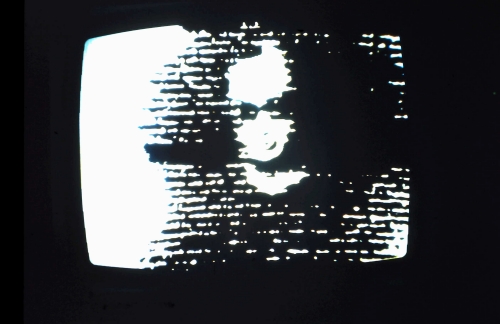
Warren Burt: Nighthawk I - image from slides, video and voice version, 1976
But that was in the future. Another musical adventure was about to begin which introduced me to a completely other set of ideas and approaches to technology.
One of the people I met in San Diego was Ron Robboy, a cellist. As we got to know each other, I realized he was far more than a cellist, but an incredibly lively and creative mind. We became close friends, sharing many mutual enthusiasms. Ron brought a number of us together to perform some of the popular classics with whatever means we had at our disposal. Popular classics such as Stravinsky's "Rite of Spring." Early meetings of this group included Ron, myself, Peter Gordon and Paul Severtson, all of us playing a number of instruments, some of which we even had some ability on. We even recorded some of these pieces with an early four track 1/4 inch reel to reel machine, using a rough-and-ready multitrack recording technique. Eventually, the group, Fatty Acid, coalesced into a trio of myself, Ron and David Dunn. I had met David earlier - sometime in my first year at UCSD. Meeting him was another breath of fresh air. He was very involved in ideas from the visual arts - ideas like earth art, environmental installation, ecological interaction, performance art, etc. He showed me so many new ideas, or things I hadn't yet encountered, that I felt that every time we talked, my mind expanded in some unexpected way.
In Fatty Acid, our usual instrumentation was Ron (a cellist) on violin, me (a lapsed keyboardist) on accordion, and David (a viola player) on mandolin, although we used other resources as needed. The same trio became the nucleus for another group, Y.C.M.A, which stood for "Young Californian Minimal Artists," but the pun was the reason for the group's name. Whereas Fatty Acid played the popular classics badly, YCMA was an umbrella for our more "serious" works, such as installations by David Dunn and myself at the La Jolla Museum of Contemporary Art, or installations by all three of us at the Golden Hills Food Co-op. Fatty Acid investigated, as a serious matter (but with a well developed sense of irony), the phenomenon of incompetence. However, incompetence, however funny, was no laughing matter. That is, we took incompetence as a metaphor for a whole range of things. For example, electronics. Through my work with Ron and David, I began taking lo-tech seriously, an interest that I would pursue for many years afterward. Here's an early recording of Fatty Acid in the pre-David Dunn, multitrack phase, playing one of our all-time greatest hits, "Spanish Patrol March, op. 383" by Theodore Moses-Tobani, harvested, like much of our repertoire, from the pages of "The Etude," an early 20th century piano teacher's journal.
Fatty Acid: Spanish Patrol March, op. 383, by Theodore Moses-Tobani (1973) (excerpt)
And here is an excerpt of classic Fatty Acid - Ron, David and Warren, playing an excerpt from the Prelude and Leibestod of Richard Wagner's immortal masterpiece, "Tristan und Isolde."
The first score shows the actual score of the piano reduction of the beginning of the Wagner. The second score shows, perhaps, a visual analogy for how we treated it.
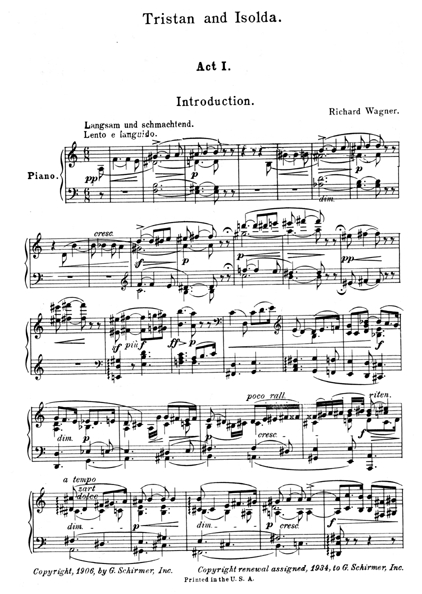
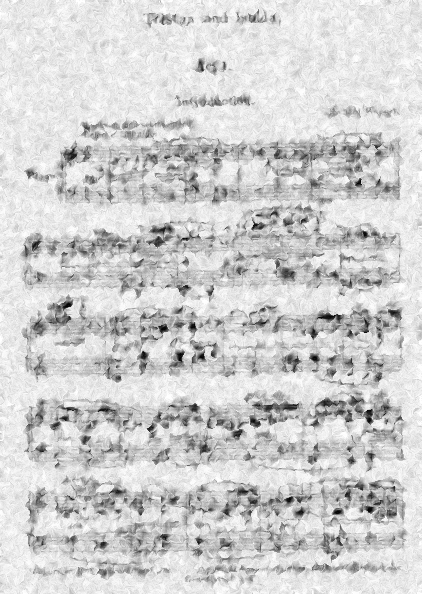
Richard Wagner: Tristan und Isolde: Before and After Fatty Acid
Richard Wagner: Tristan und Isolde - Prelude und Leibestod (excerpt): Performed by Fatty Acid
Here are a couple of pictures of Fatty Acid performing on July 14, 1974 in the courtyard of the La Jolla Museum of Contemporary Art. Following that is a picture of a similar group that Arnold Schoenberg played in about 1905. Schoenberg is on cello. Fritz Kreisler is the violin player on the left. Not only did we have cordial relations with our British counterparts, the Portsmouth Sinfonia, but we discovered that our work had historical precedents with young Austrian secessionists!
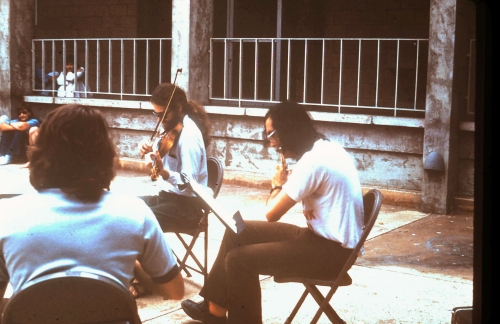
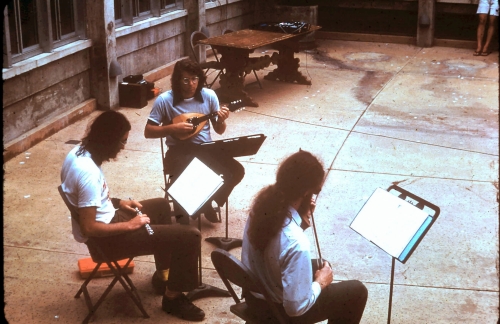
Fatty Acid - July 14, 1974 concert at the La Jolla Museum of Contemporary Art (now known as the Museum of Contemporary Art, San Diego) - David Dunn, mandolin, Warren Burt, flute, Ron Robboy, violin.
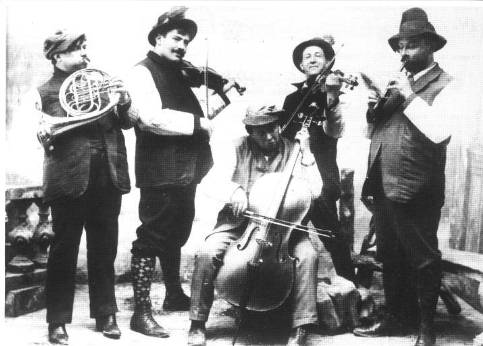
Arnold Schoenberg, Fritz Kreisler and friends anticipate Fatty Acid - Vienna, 1905
We also performed together as YCMA. YCMA did a number of events. Performances took place at the Center for Music Experiment at UCSD; at San Diego State University; at the Golden Hills Food Co-op; and at the La Jolla Museum of Contemporary Art; as well as in various environmental locations. For a performance given at the Center for Music Experiment, called "Narcissus," we collaborated with dancer Kim Pauley, the first of many dancers I have collaborated with over the years. In "Narcissus," the dancer sat on a very high stool. The camera was trained on her shoulders, neck and head. She did a stationary very slow motion dance, concentrating on upper trunk and head, and arm motions. Her image was modified by our video synthesis equipment - in fact, she used the modifications of her image on the screen as a kind of score for her motion. Here are 3 stills from the video that resulted from "Narcissus."
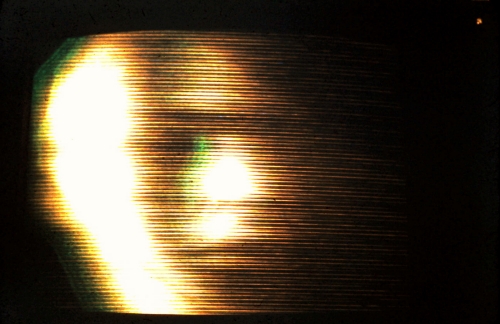
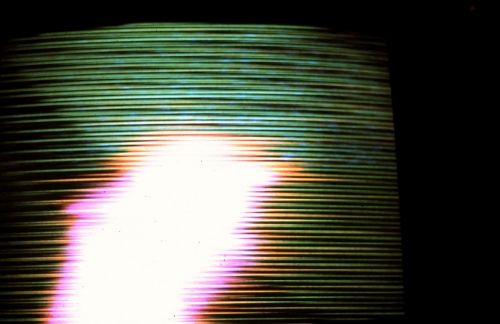
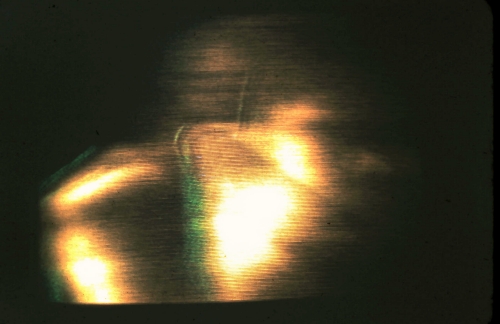
YCMA: Narcissus - featuring dancer Kim Pauley, CME performance, UCSD 1973-4
Two of our major performances took place in the summer of 1974 at the La Jolla Museum of Contemporary Art. In the first, we performed two works of mine, "California Fantasy" and "Offenbach Loops." "California Fantasy" was a drone piece in which a single mode was sustained for the duration of the piece. Unlike the drone pieces by, for example, Harold Budd and Charlemagne Palestine which may have influenced it, this piece was done with minimal means - two Sunrise battery powered toy reed organs and a Synthi AKS. "Offenbach Loops," inspired by the loop-based minimalist cut-ups made with popular-classic materials a number of my British composer friends were doing, was for three toy pianos.
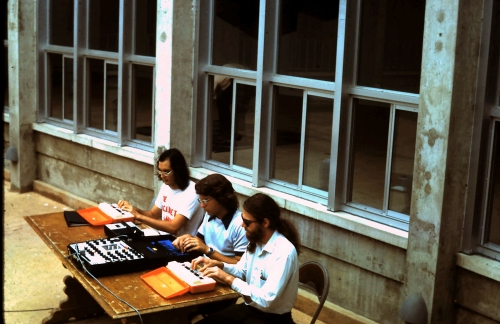
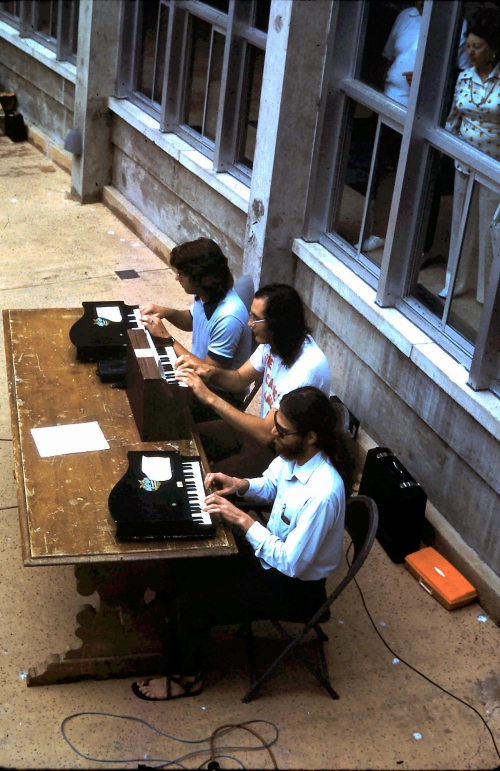
YCMA perform Warren Burt: California Fantasy (top) and Offenbach Loops (bottom)
The cheaper end of technology, while not our exclusive interest, was a major factor in YCMA performances. On the program for YCMA 3, given July 14, 1974 at the La Jolla Museum of Contemporary Art, one can see that we also performed "Oracles (paragraph 5)" a piece by David Dunn for 6 cassette recorders. We were in the process of developing the cassette recorder as a serious portable electronic music instrument, a process that would continue in the future.
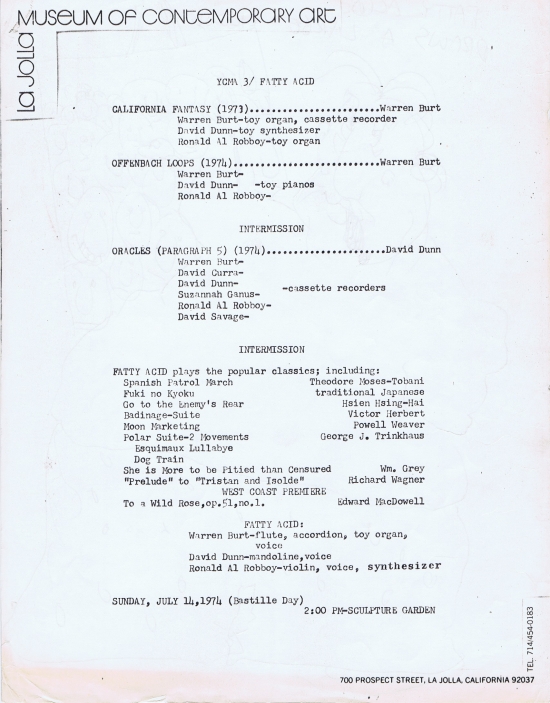
Sound sculpture was also an interest of YCMA. On our August 11, 1974 concert, also given at the La Jolla Museum of Contemporary Art, all the works were sculptural or installation based. Three of the works were David Dunn's "Oracles (paragraph 2)" for loudspeakers in tidepools, and my own "Mr. Burt his Memory of Mr. White his Fantasy on Mr. Dunstable his Musick," and "Flying Pickle Music for Donald Roller Wilson." The Dunn piece existed in two versions - a taped version that we prepared earlier in the week, which was installed at the Museum on the day of performance, and a live version at the tidepools during the show. As the reconstructed poster (the original was damaged in a flood a few years ago) shows, the live version was washed out during the performance, but the installed tape version played on. Here are two photographs of David and myself preparing the taped version in the week before the performance.
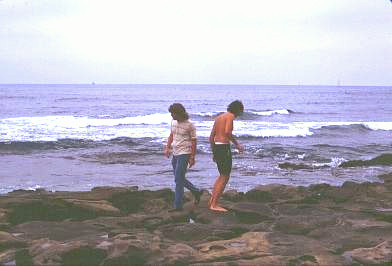
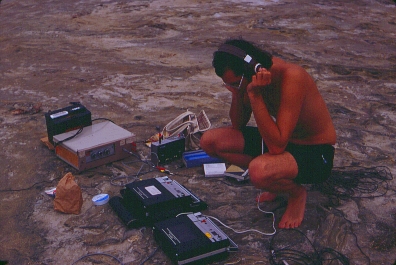
David Dunn: Oracles (paragraph 6) installation and preparation at La Jolla Tidepools by David Dunn and Warren Burt
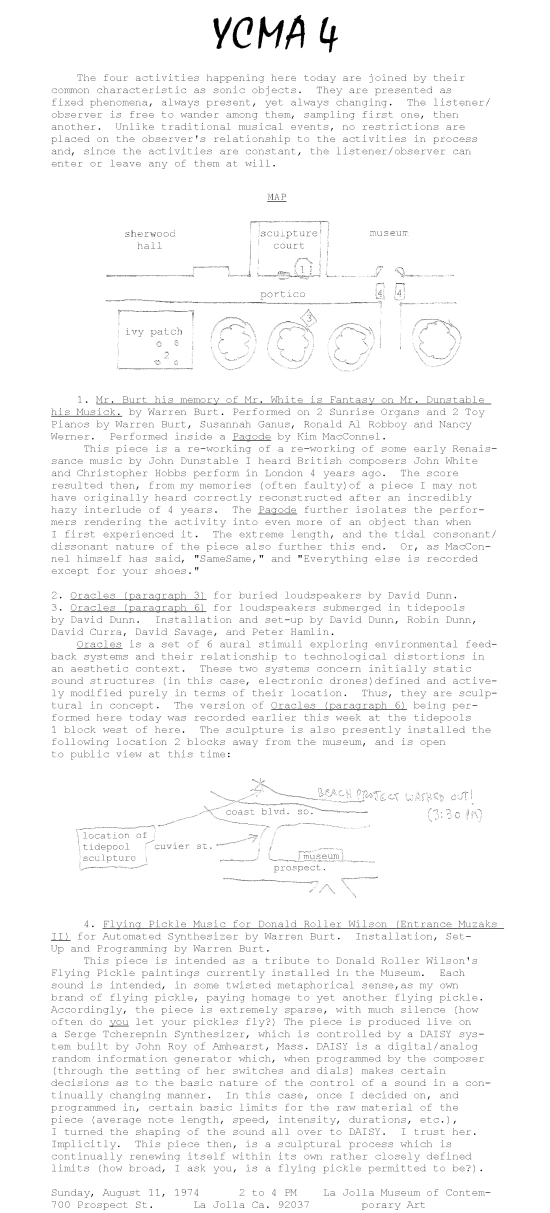
"Mr. Burt his Memory of Mr. White his Fantasy on Mr. Dunstable his Musick" was a 4 hour long piece for 2 toy organs and 2 toy pianos, performed in a Pagode, by artist friend Kim MacConnel. The program note above explains how the piece worked, and these photos show the Pagode from several angles, and how we performed in it.
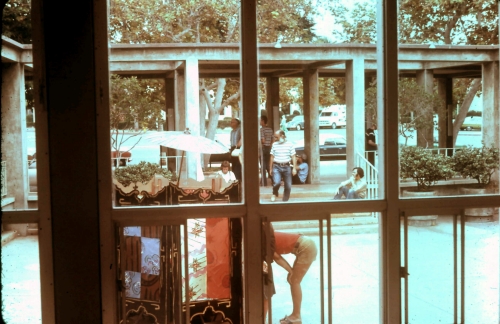
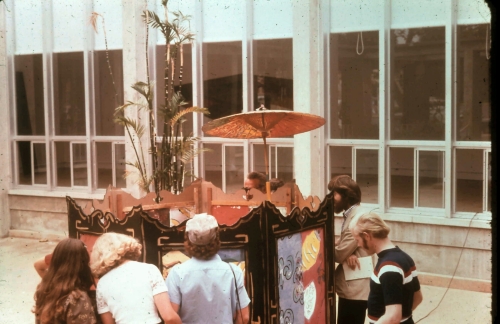
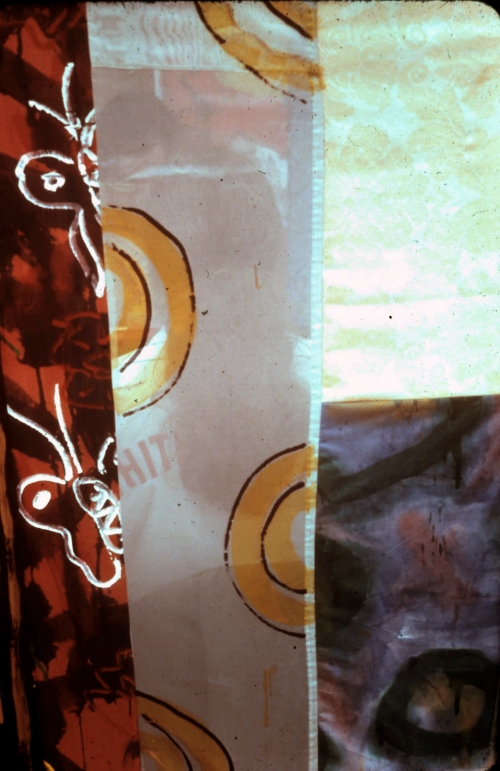
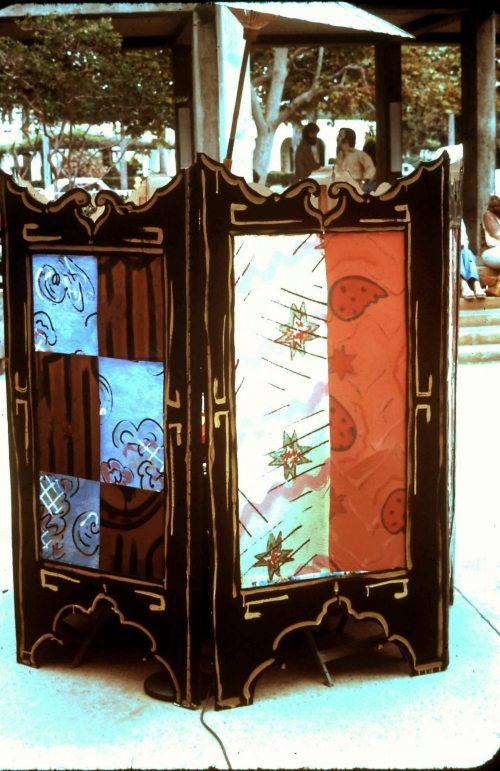
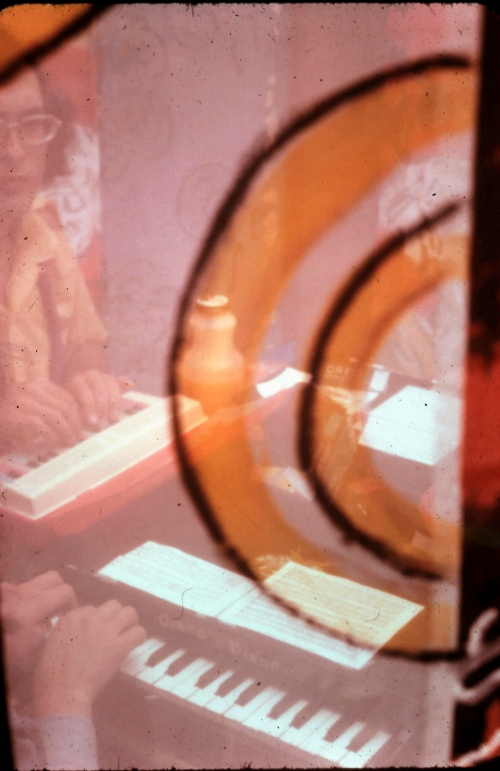
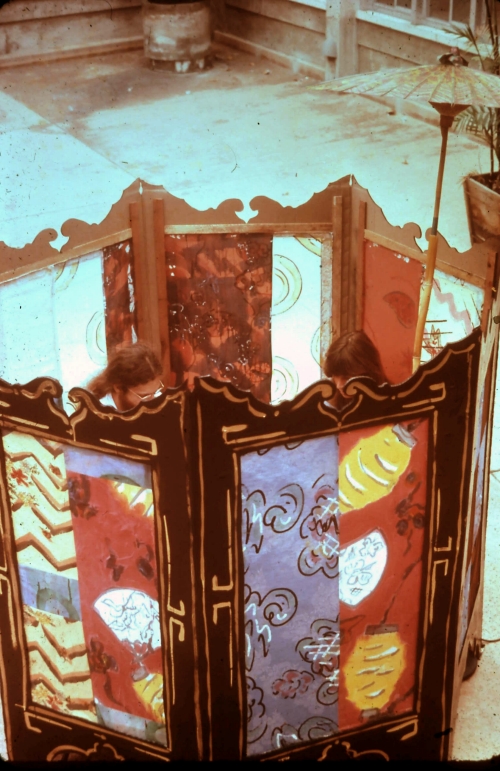
Warren Burt: Mr. Burt his Memory of Mr. White his Fantasy on Mr. Dunstable his Musick (1974) performed inside Kim MacConnel: Pagode (1974) by YCMA: Warren Burt, Susannah Ganus, Ron Robboy, Nancy Werner.
"Flying Pickle Music" was heard out of two loudspeakers at the entrance to the Museum. The sounds whizzed between the loudspeakers. I was told that for quite a while, a little dog sat between the loudspeakers, absolutely entranced, the movements of its head following the motion of the sounds as they whizzed between the loudspeakers. Since we were involved with David Dunn's pieces, some of which involved inter-species communication, it was of particular delight to us that the member of the public who gave this piece the most careful attention was canine, not anthropoid. As the program indicates, "Flying Pickle Music" was for live Serge Synthesizer controlled by DAISY. These were both machines that I had built or ordered for the analog studio at the Center for Music Experiment at UCSD, where I was a Fellow at the time. This leads us back slightly in time to explain how this came about.
In 1973, several things came together that led me in particular technological directions. Through Randy Cohen and Rich Gold, two fellow SUNY Albany students who had started graduate studies at California Institute of the Arts in Los Angeles, I met Serge Tcherepnin. He and a number of people at CalArts and elsewhere formed the People's Synthesizer Project - a mutual self-help project to build a synthesizer that we all could afford. This later morphed into Serge Modular Music Systems, Serge's company. At the same time, I became a Research Fellow at the newly formed Project, later Center for Music Experiment at UCSD. (Today known as the Center for Research in Computing and the Arts (CRCA).) My task was to put together an analog music and video synthesis studio. Also at this time, I began to get seriously interested in microtonality. The air in San Diego was filled with microtonality, of course, with Harry Partch living and working there. Many of my friends, such as Ron Robboy and David Dunn, were assistants to Partch, so his influence loomed large. (Unfortunately, I never met Partch. Bad timing on my part.)
As part of my Research Assistantship at PME, I proposed that the core of the studio be one of the new Serge systems. This would be augmented with DAISY, a pseudo-random sequence generator designed by Joel Chadabe and John Roy, a synthesizer built by Bruce Rittenbach, another CME Fellow, and a video interface box built by Steve Beck. I went up to Los Angeles and under Serge's watchful eye, built the Serge system for PME. Here's a picture of Serge in those early days with one of his first systems.
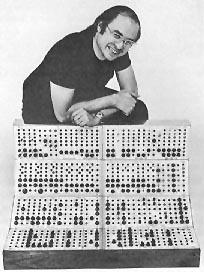
Serge Tcherepnin, early 1970s, with an early Serge system.
And here are some pictures of the analog studio that I designed for CME. The Serge is pictured here, as is Daisy, the Rittenbach SRA synth, and the Beck video interface. Also of note are a number of small creatures who began attending to machines that I was involved with, and who continue, in various incarnations, to fulfil this function even today.
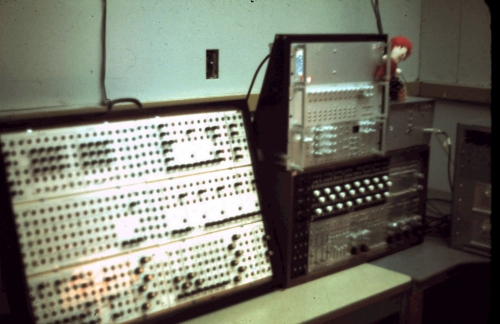
CME Analog Studio 1974, overview
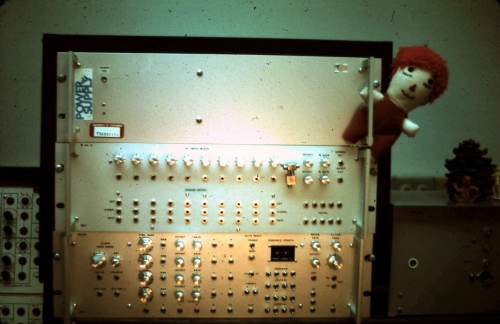
CME Analog Studio, 1974, DAISY system designed by Joel Chadabe and John Roy
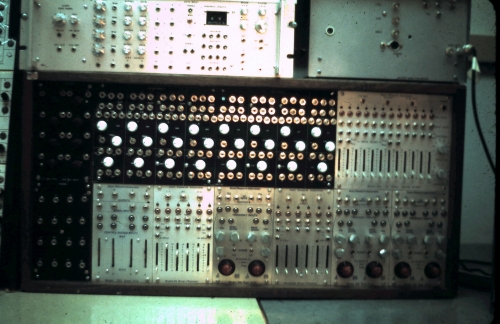
CME Analog Studio, 1974, SRA Synthesizer built by Bruce Rittenbach, Video Encoder (upper right) built by Stephen Beck
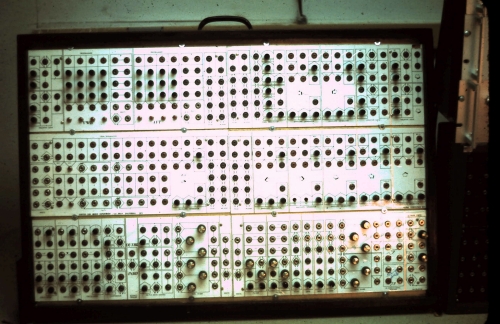
CME Studio, 1974, Serge Synthesizer, specified and built by Warren Burt
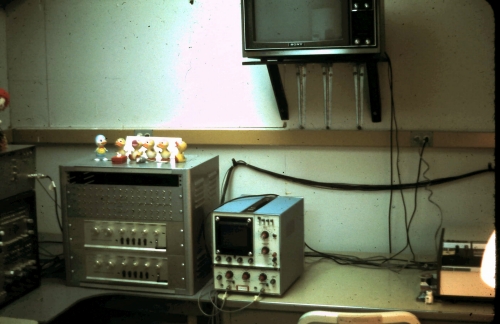
CME Studio, 1974, Video wall overview with ducks.
And here are three other pictures from the studios at CME. The first shows the large PDP-11 system used then, with composer Bruce Leibig working in front of it. The second shows Ed Kobrin's Hybrid IV system, which had computer logic controlling analog oscillators, and there is also a picture of a mini-computer system which controlled a high-speed high quality Digital to Analog converter, for computer sound synthesis work. I was not involved to a great extent with the computer at this time. Working in real-time was of greatest importance to me, so digital devices which emulated the function of computer programs, such as DAISY, were more useful to me then. I did a couple of exercises generating sound with computers (reams of paper print-outs for a few seconds of sound, etc), and I did one collaboration with UCSD science grad student J. Christopher Wells on the PDP-11, where the computer generated control signals for the synthesizer in real time (the computer program was emulating the current understanding of the motion of electrons in a black hole), but mostly, my interests were in generating sound in real time, which, to a large extent, is still true today.
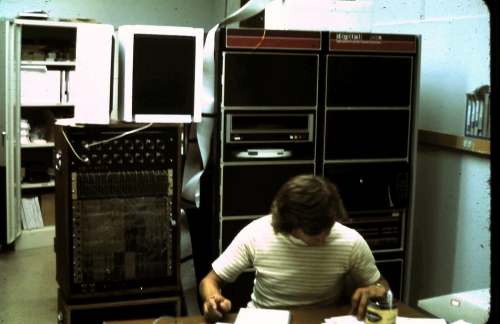
CME Studios, 1974 - PDP-11 computer with Bruce Leibig in foreground. Ed Kobrin's Hybrid IV system is on the left of the PDP-11.
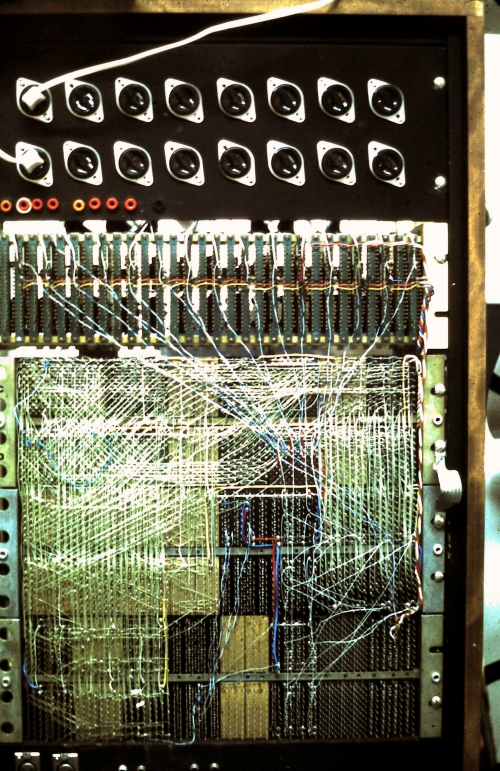
CME Studios, 1974 - Ed Kobrin, Hybrid IV system
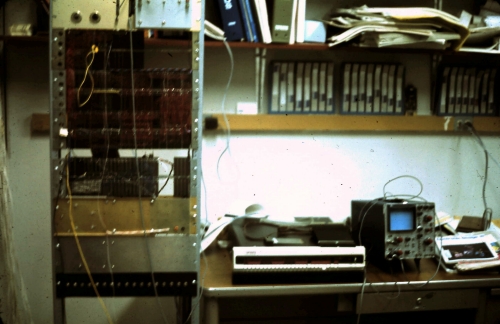
CME Studios, 1974 - Mini-computer with FOCAL D-to-A.
And here's a picture of Ken Stone's studio, in the Dandenong Ranges, outside Melbourne. The machine hanging from the ceiling on the right is indeed the Serge I built for CME. It has had a long and distinguished career. In the late 70s, CME decided to go all digital. By this time, I had moved to Melbourne. I heard about this, and offered to buy the system for the Clifton Hill Community Music Centre, of which I had been one of the founders. After a time at CHCMC, it wandered from owner to owner, eventually settling for the longest period in the ownership of Rainer Linz, who used it for many performances with Stelarc. Finally, it made its way to Ken Stone's studio, where it still lives today.
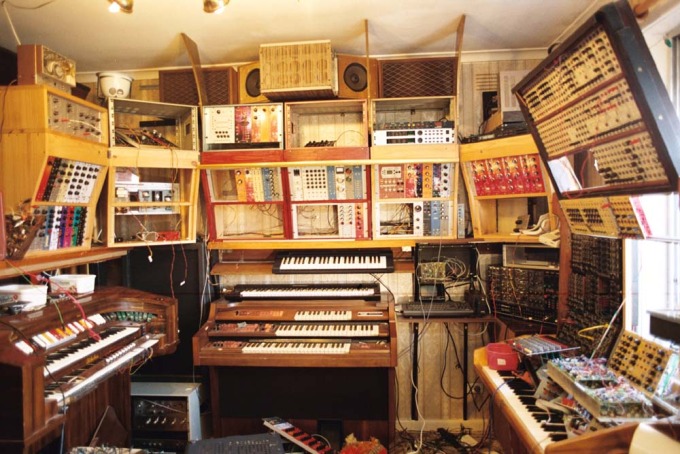
Ken Stone studio, Dandenong Ranges, Victoria, Australia, early 2000s, with CME Serge hanging on the upper right.
This piece, "For Anne, who broke my heart" is a live performance with the DAISY system controlling the Serge. It was one of the first pieces completed in the PME studio. Of particular relevance here is the fact that the oscillators on the Serge had a sync input, which allowed the synced oscillator to play exact divisions of the frequency of the sync oscillator. In musical terms, this would create a pure sub-harmonic series. I very much liked the sound of the subharmonic intervals, and this was one of several things that cemented my interest in microtonality.
for Anne, who broke my heart (1974) (excerpt)
One essential component of the CME Analog studio was a video interface box built for us by Stephen Beck. This box was simplicity itself - video sync outputs and Red, Green and Blue inputs. This enabled us to experiment with using analog synthesizer and camera inputs to create video material. Since the Serge synthesizer had sync inputs, we could generate (relatively) stable signals to create video synthesis pieces with. Here are stills from two pieces I made back then, "SeaScape/Skyscape," and "A Guided Tour to the Caves of Uranus." The imagery may have been simple, but the possibility of creating video pieces with real time control was a powerful one, and was an idea I would continue to explore.
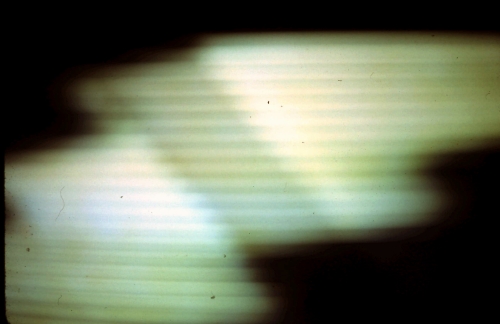
Warren Burt: Seascape / Skyscape, for video and electronic sound - CME Studios, 1973
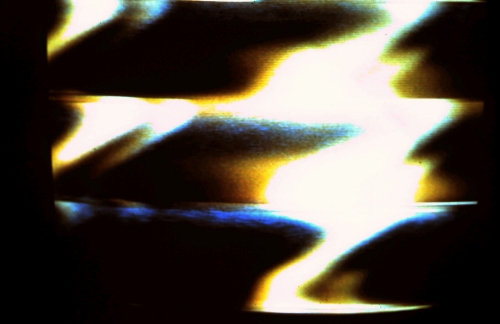
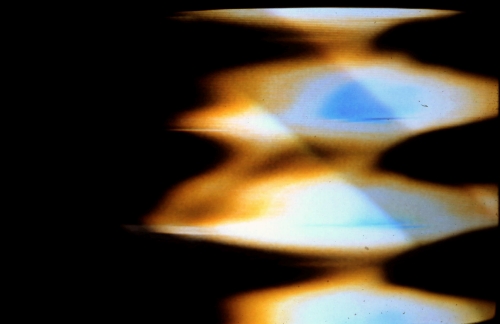
Warren Burt: A Guided Tour to the Caves of Uranus, for video and electronic sound, 1974
Another encounter that encouraged my interest in microtonality was meeting Charlemagne Palestine, at that time a junior faculty member in the Music School at CalArts. I heard he was giving a 4 day long performance at the Theatre Vanguard on Melrose Ave. in West Hollywood, and given my interest in events of long duration, decided I would go up there and experience the whole thing. It was magical, and one of the things that impressed me was Charlemagne's use of drones. They seemed to have a unique timbre. He explained to me that he had had some very stable precise oscillators built for him by Serge, and that he tuned two or three sine wave oscillators to each pitch, detuning them slightly to get different rates of beating, or rhythmic throbbing, for each pitch. Curious about this, on a summer trip back to Albany, I went to the CEMS Moog studio, and set up this kind of beating with the multi-oscillator Moog. The results pleased me, and with the addition of a short surrealist poem I found in a dream, mixed in at the end, I made the composition called "for Charlemagne Palestine." I was still a bit nervous about having "so little" activity on the surface of my music, however, so I rather diffidently presented the piece to Kenneth Gaburo, almost apologetically. Anyone who knew Gaburo knows that presenting things to him with uncertainty was a very very bad move. To Kenneth, one should never ever have said, "It's not very good, but...." "Well if it's not very good, why should I listen to it?" would be his inevitable reply. After the obligatory lecture about never presenting work in an uncertain manner, he said he liked the work, and what he liked about it was that in this work, for the first time, he was hearing me show my softer, more sensitive side. This was a side of me that I shouldn't hide, but should in fact share with people - it was one of the very good things I had to offer, he said. Interesting advice to a boisterous male in his early 20s. It's advice I've tried to pass on to people in many circumstances.
for Charlemagne Palestine (1973) (excerpt)
The final thing that got me hooked on microtonality was a visit to CME by Herman Pedtke, one of the inventors of the Motorola Scalatron. The Scalatron was a microtonal organ. It had two manuals, and 10 push buttons to tune each key on each of the two manuals. That is, each key could be tuned to any one of 1024 different pitches (2 to the 10th). The Scalatron Pedtke brought to demonstrate had normal piano style keys. Other Scalatrons were built with more elaborate "generalized" Bosanquet style keyboards, but I never got to see them. This, by the way, was the same trip to San Diego where Pedtke brought the Scalatron to Harry Partch, who on seeing it, said "It's just what I needed, 40 years too late." While the Scalatron was at CME, I made several improvisations with it. One was in 18 tones per octave - I had heard Busoni had experimented with that scale, so I decided I would. Another improv was in a more exotic scale, the details of which I can't remember at the moment. The recordings of both these improvisations were processed through a distortion process I developed where I played a recording through a tape recorder with the input levels up full. The output of this distortion would be played through the filters on the Serge, and then recorded at full level on another recorder. The resulting recording would be then put through the same process again, etc. This had the effect of changing the Scalatron's timbre, and introducing quite crunchy noisebands into the mix. There are two excerpts here, both of which use this. The first, from "Busonianiania" (1973) is in 18 tone equal temperament. The second, from the very end of "French Fried Minds of Walruses and Caterpillars" (1973) is in a more ambiguous tuning, and builds into broad band noise before cutting to an almost inaudible recording of waves at Lake St. Mary's, Arizona. I was very interested at this time in the contrast between full on noise, and incredibly quiet environments. The ending of this piece was my way of showing this. Here is a picture of the Scalatron with normal keyboard, the one that was in the studio at La Trobe University in Melbourne for many years. If you expand this photo, and look under the clear plastic cover above the keys, you'll see the multiple rows of 10 push buttons each with which you tuned the Scalatron.
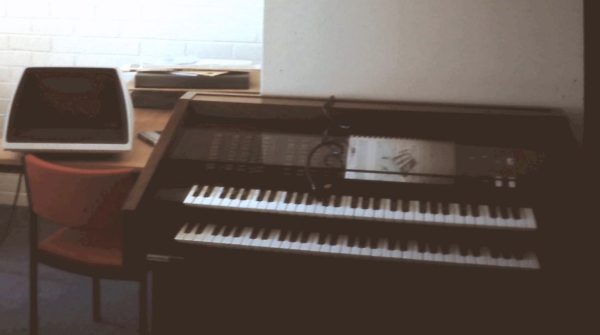
Motorola Scalatron Microtonal Organ - La Trobe University Studio, Melbourne, 1976
Busonianiania (1974) (excerpt)
French Fried Minds of Walruses and Caterpillars (1974) (excerpt)
The other big influence on me during my years at UCSD was Robert Erickson, who was my other principal teacher. In 1974, he gave a seminar on musical timbre, which introduced many of us to the world of psycho-acoustic research. It was, again, one of those life changing experiences. One of the things we informally researched was the limits of the human ear-brain in being able to distinguish rapidly changing timbres. We did this through tape splicing, exploring pitch, timbre, range-differences, texture differences, etc. and their effect on distinguishing timbres that very rapidly alternated. He had a contest at the end of term - the person who could successfully cram the most distinguishable timbres into a minute would win a bottle of whiskey. This was an irresistible challenge for me, and I plunged into splicing tape with the zeal of a razor-blade wielding maniac. (Which, in fact, is what I was!) I won the contest, and Bob was momentarily heartbroken - "But you don't drink!" he said. I assured him that my father did drink, and was in fact a connoisseur of fine whiskeys, so the prize would not go to waste. (Fade into old Hollywood movie scene of a composer with fingertips bleeding from too many late-night careless splices - "I did it all for you, Dad!") This seemed to amuse him greatly, and I can report that for many years, my father savored the results of my labors.
Another piece Erickson was working on at the time was called "Loops - An Informal Timbre Experiment." This involved 5 or 6 wind instruments playing hockets with a series of simple minimalist riffs. The results of the work were published by him in an article, and the techniques developed were incorporated into a number of his later orchestral works, such as the utterly gorgeous "East of the Beach" (1980). In 1978, well after I had left UCSD, with my Serge, I managed to set up a patch that, through multiple sequencers and frequency modulation techniques, emulated the effect of his hocketing in "Loops." I called the piece "reLoopse" and when I played it to him a couple of years later, he was delighted.
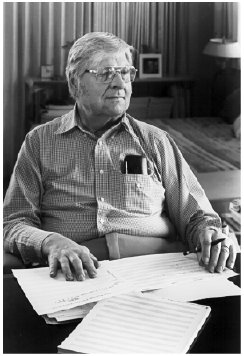
Robert Erickson, San Diego, 1980s
At UCSD, in 1974-75, at the urging of Jean-Charles Francois and Keith Humble, a student-run performance series was set up called "The Atomic Cafe." It featured more informal performances, done in a cafe environment, although still on campus. I became a little involved with the running of it, although as I remember, the principle movers and shakers were Ron Nagorcka and his then-wife Sue Thurgate, and Tom and Pixie Nunn. One day in early 1975, I was supposed to present a piece, but I had to be out of town then. My solution was to make a piece that could be played in my absence. Since the Atomic Cafe had no permanent sound system, I designed the piece so it could be played out of three cassette recorders. Borrowed from David Dunn, this was my solution to the problem of a portable, low-cost multi-channel sound system. I wrote a sound poem, "Frou-Frou Flamingo," using a substitution technique my fellow student Ned Sublette had introduced me to. In it, I not only gradually substituted one word-phrase for another, but also substituted words with sounds from my collection of toy instruments. "Frou-Frou Flamingo" became the first part of "Nighthawk, Part II - Three Poems of Substitution and Re-Assemblage," which eventually was for four-channel tape and slides of the texts. But for this performance, three cassette recorders was what it was played out of. The use of cassettes and other cheap electronics was an idea that struck a chord with a number of us at this time. In fact, if memory serves me, it was about this time that Ron Robboy came up with the saying "Cassette recorders and Instamatic cameras are the pert little nipples of seamy conceptual art!" Or was that later? And was it Ron Robboy who said it? Among those who were investigating the use of cheap technology was Ron Nagorcka, and in July 1975, when I moved to Australia, and Ron returned there as well, we formed a group, Plastic Platypus, designed to explore the low-tech end of things as a kind of people's electronic music. Although there were a number of other people exploring the use of cheap technology at this time, I think I can safely say that we were among the first to systematically explore the use of cassettes as a serious electronic music making medium. The picture below is not of one of the cassettes used in 1975. It's of a slightly later vintage - about 1977. Note the switch on the lower left of the machine. This turns off the erase head, allowing multiple generations of sound to be built up.

Radio Shack Cassette Recorder, 1977, with switch for defeating erase head
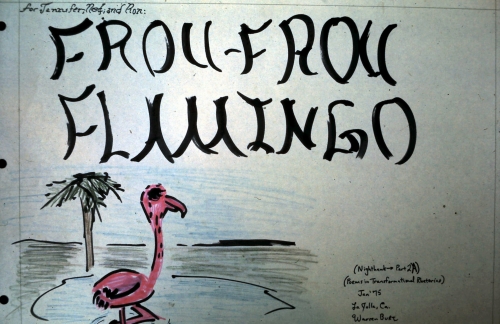
Warren Burt: Nighthawk 2A: Frou-Frou Flamingo. Cover of Score (1975)
Frou-Frou Flamingo (1975) (excerpt)
Meanwhile, in addition to all this other work, I was working on my thesis project, which was the building of my own electronic music system. This was Aardvarks IV, a machine with 16 digital random control voltage generators, 4 sequencers, 16 gates, and various mixers and filters. A more complete description of the machine can be found in my master's thesis, available HERE. Although it may seem like a very straight engineering project, in fact, a lot of my interests in incompetence and low-tech were incorporated into Aardvarks IV. For example, each of the digital to analog converters (DACs) on the 16 shift-register feedback random control voltage generators was hand made. Some of them used fine resistors, others used very cheap resistors, and some used resistors treated in a way Kenneth Gaburo suggested to me - they were placed on a hard surface with a soft washcloth under them, and gently hit with a hammer. Then they were tested. If the resistor was just slightly cracked or compromised with the hammer, it would be more inaccurate that even a low-accuracy tolerance resistor. Thus, each of the 16 DACs was unique. This meant that each of the random voltages, when applied to an oscillator, would produce a different set of pitches. Intentionally, I built a set of found objects not only into the logic of my circuits, but in how the output of those circuits were realized as well. I used Aardvarks IV regularly, as a central part of my studio until the late 1990s. In the early 1990s, Russ Kozerski's PC-only program "Sound Globs" (also a product of UCSD!) generated highly specifiable real-time random MIDI control signals, and I made extensive use of that. But I also kept using Aardvarks IV. Then, in 1998, with John Dunn's program SoftStep (and later in his ArtWonk), I built a module which emulated the functioning of the shift-register feedback random voltage generators, and never looked back.
Aardvarks IV, in fact, was my answer to the problem of the then expense and non-portability of computers - it was designed as an emulation in hardware of the computer program I would have liked to have written. It provided me with the logic I wanted, but in a form that I could afford, and carry around (in an accordion case, no less!).
Here are a number of photos of Aardvarks IV, followed by two excerpts from Aardvarks IV - the 1975 version, where I feel I successfully realized the ideas first put forth in the 1972 Aardvarks IV series of pieces. The first picture, taken by Roberto Laneri, has me sitting on the Aardvarks IV with the power cord in my mouth. This is followed by a number of pictures of Aardvarks IV where various details of the construction are shown. Note the incredible amount of wire-wrapping involved in the machine. The final pictures show Aardvarks IV together with some Serge modules and other electronics in a performance of Aardvarks V, in 1977 at La Trobe University. Which is where this journey will take us next - to La Trobe University, Melbourne, from 1975-1978.
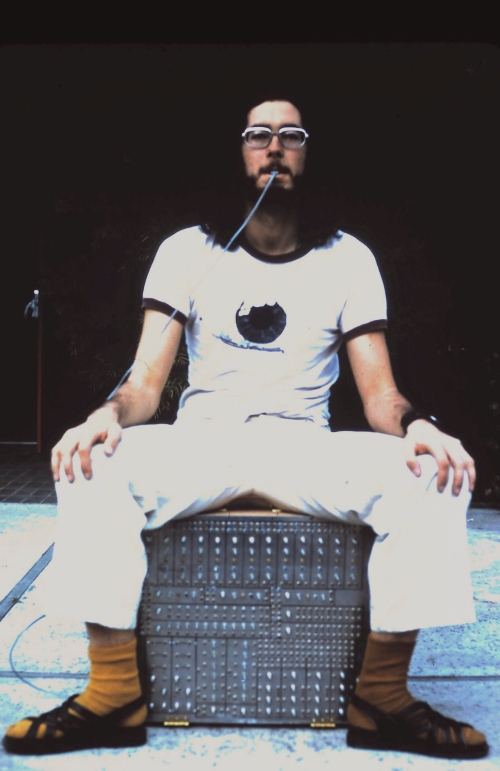
Warren Burt with Aardvarks IV, 1975, UCSD - photo by Roberto Laneri
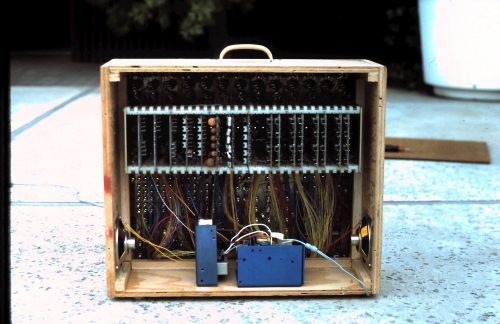
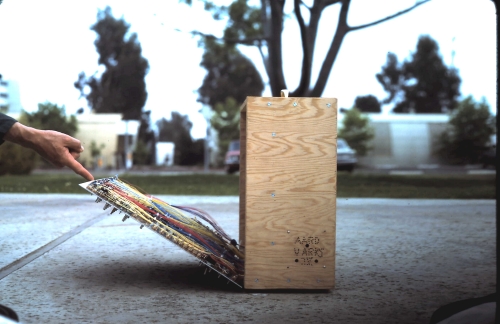
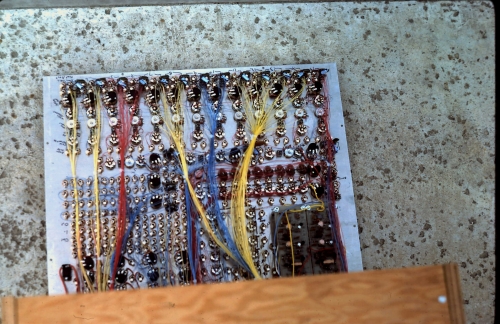
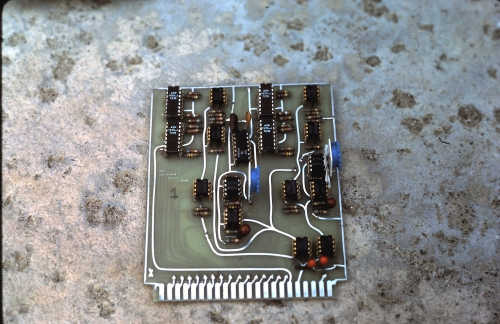
Warren Burt: Aardvarks IV (1975) Construction detail photographs
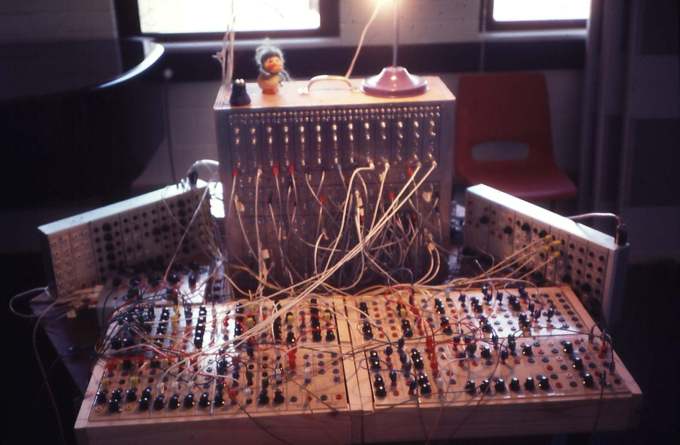
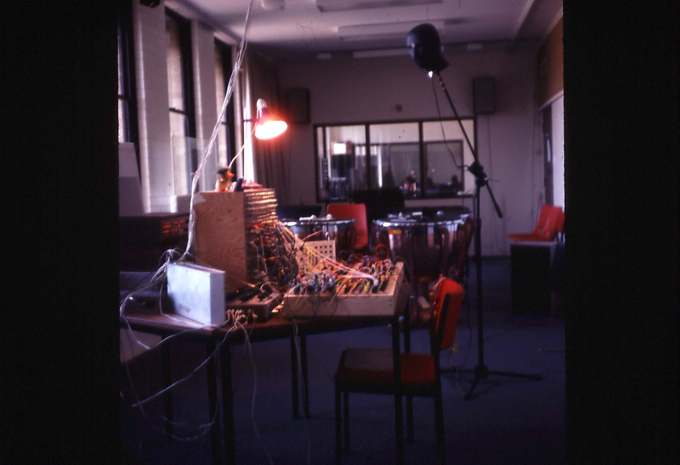
Aardvarks V - Aardvarks IV, Serge modules, other electronics. La Trobe University, 1977 - two views
Aardvarks IV (1975) (excerpt from about the middle of the piece)
Aardvarks IV (1975) (excerpt from near the end of the piece)
Real Science Comix Funnies #1: John Lilly Meets the Dolphins (1972) (excerpt)


